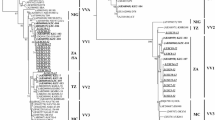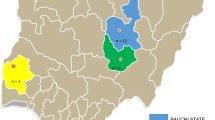Abstract
The present study was undertaken to characterize field isolates of infectious bursal disease virus (IBDV). The identification was done using reverse transcription-polymerase chain reaction (RT-PCR) and partial sequencing of the VP2 gene. Pooled bursal samples were collected from commercial broiler farms located in the Kurdistan Regional Government (KRG) of Iraq. The genetic material of the IBDV was detected in 10 out of 29 field samples. Sequences of the hypervariable VP2 region were determined for 10 of these viruses. Molecular analysis of the VP2 gene of five IBDVs showed amino acid sequences consistent with the very virulent (vv) IBDV. Two samples were identified as classic vaccine viruses, and three samples were classic vaccine viruses that appear to have mutated during replication in the field. Phylogenetic analysis showed that all five field IBDV strains of the present study were closely related to each other. On the basis of nucleotide sequencing and phylogenetic analysis, it is very likely that IBD-causing viruses in this part of Iraq are of the very virulent type. These IBDVs appear to be evolving relative to their type strains.


Similar content being viewed by others
References
Al-Sheikhly, F., Mutalib, A. A. and Rasheed, D. K., 1978. Infectious bursal disease in chickens. 4th annual conference of Iraq Veterinary Medical Association, Baghdad, pp. 13.
Banda, A. and Villegas, P., 2004. Genetic characterization of very virulent infectious bursal disease viruses from Latin America. Avian Diseases, 48, 540–549.
Bayliss, C. D., Spies, U., Shaw, K., Peters, R. W., Papageorgiou, A., Müller, H. and Boursnell, M. E., 1990. A comparison of the sequences of segment A of four infectious bursal disease virus strains and identification of a variable region in VP2. Journal of General Virology, 71, 1303–1312.
Becht, H., 1981. Infectious bursal disease virus. Current Topics Microbiological Immunology, 90, 107–121.
Brandt, M., Yao, K., Liu, M., Heckert, R. A. and Vakharia, V. N., 2001. Molecular determinants of virulence, cell trophism, and pathogenic phenotype of infectious bursal disease virus. Journal of Virology, 75, 11974–11982.
Brown, M.D., Green, P. and Skinner, M. A., 1994. VP2 sequences of recent European “very virulent” isolates of infectious bursal disease virus are closely related to each other but are distinct from those of “classical” strains. Journal of General Virology, 75, 675–680.
Cosgrove, A. S., 1962. An apparently new disease of chickens avian nephrosis. Avian Diseases, 6, 385–389.
Eterradossi, N., Arnaud, C., Tekaia, F., Toquin, D., Le Coq, H., Rivallan, G., Guittet, M., Domenech, J., van den Berg, T. P. and Skinner, M. A., 1999. Antigenic and genetic relationship between European very virulent infectious bursal disease viruses and an early West-African isolate. Avian Pathology, 28, 36– 46.
Eterradossi, N. and Saif, Y. M., 2008. Infectious bursal disease. In: Diseases of poultry, 12th edition (eds. Saif, Y. M., Fadly A. M., Glissen J. R., McDougald L. R., Nolan L. K. and Swayne D. E.) Wiley-Blackwell, pp. 185–208.
Heine, H. G., Haritou, M., Failla P., Fahey, K. and Azad, A., 1991. Sequence analysis and expression of the host-protective immunogenVP2 of a variant strain of infectious bursal disease virus which can circumvent vaccination with standard type I strains. Journal of General Virology, 72, 1835–1843.
Hon, C. C., Lam, T. Y., Drummond, A., Rambaut, A., Lee, Y. F., Yip, C. W., Zeng, F., Lam, P. Y., Ng, P. T. and Leung, F. C., 2006. Phylogenic analysis reveals a correlation between the expansion of very virulent infectious bursal disease virus and reassortment of its genome segment B. Journal of Virology, 80, 8503–8509.
Hoque, M. M., Omar, A. R., Chong, L. K., Hair-Bejo, M. and Aini, I., 2001. Pathogenicity of SspI-positive infectious bursal disease virus and molecular characterization of the VP2 hypervariable region. Avian Pathology, 30, 369–380.
Jackwood, D. J., 2004. Recent trends in the molecular diagnosis of infectious bursal disease viruses. Animal Health Research Review, 5, 313–316.
Jackwood, D. J., Sreedevi, B., LeFever, L. J. and Sommer-Wagner, S. E., 2008. Studies on naturally occurring infectious bursal disease viruses suggest that a single amino acid substitution at position 253 in VP2 increases pathogenicity. Virology, 377, 110–116.
Lasher, H. N. and Shane, S. M., 1994. Infectious bursal disease. World's Poultry Science Journal, 50, 133–166.
Lee, L. H., Yu, S. L. and Shieh, H. K., 1992. Detection of infectious bursal disease virus infection using the polymerase chain reaction. Journal of Virological Methods, 40, 243–253.
Le Nouën, C., Rivallan, G., Toquin, D., Darlu, P., Morin, Y., Beven, V., de Boisseson, C., Cazaban, C., Comte, S., Gardin, Y. and Eterradossi, N., 2006. Very virulent infectious bursal disease virus: reduced pathogenicity in a rare natural segment-B-reassorted isolate. Journal of General Virology, 87, 209–216.
Snyder, D. B., Lana, D. P., Savage, P. K., Yancey, F. S., Mengel, S. A. and Marquardt, W. W., 1988. Differentiation of infectious bursal disease viruses directly from infected tissues with neutralizing monoclonal antibodies: evidence of a major antigenic shift in recent field isolates. Avian Diseases, 32, 535–539.
Tamura, K., Peterson, D., Peterson, N., Stecher, G., Nei, M. and Kumar, S., 2011. MEGA5: molecular evolutionary genetics analysis using maximum likelihood, evolutionary distance, and maximum parsimony methods. Molecular Biology and Evolution, 28, 2731–2739.
van den Berg, T. P., Gonze, M. and Meulemans, G., 1991. Acute infectious bursal disease in poultry: isolation and characterization of a highly virulent strain. Avian Pathology, 20, 133–143.
van den Berg, T. P., Morales, D., Eterradossi, N., Rivallan, G., Toquin, D., Raue, R., Zierenberg, K., Zhang, M. F., Zhu, Y. P., Wang, C.Q., Zheng, H. J., Wang, X., Chen, G. C., Lim, B. L. and Muller, H., 2004. Assessment of genetic, antigenic and pathotypic criteria for the characterization of IBDV strains. Avian Pathology, 33, 470–476.
Acknowledgments
We thank the Ohio Agricultural Research and Development Center, Ohio University, USA, for partly funding this study. We also would like to thank the Barash Company in Erbil, KRG, for helping collect the samples from the broiler farms.
Conflict of interest
The authors declare that they have no conflict of interest.
Author information
Authors and Affiliations
Corresponding author
Rights and permissions
About this article
Cite this article
Amin, O.G.M., Jackwood, D.J. Identification and molecular analysis of infectious bursal disease in broiler farms in the Kurdistan Regional Government of Iraq. Trop Anim Health Prod 46, 1297–1301 (2014). https://doi.org/10.1007/s11250-014-0643-0
Accepted:
Published:
Issue Date:
DOI: https://doi.org/10.1007/s11250-014-0643-0




